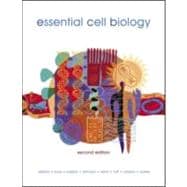
Note: Supplemental materials are not guaranteed with Rental or Used book purchases.
Purchase Benefits
What is included with this book?
| Introduction to Cells | p. 1 |
| Light and electron microscopy | p. 8 |
| Cells: the principal features of animal, plant, and bacterial cells | p. 25 |
| How We Know: Life's common mechanisms | p. 30 |
| Chemical Components of Cells | p. 39 |
| How We Know: What are macromolecules? | p. 60 |
| Chemical bonds and groups | p. 66 |
| The chemical properties of water | p. 68 |
| An outline of some of the types of sugars | p. 70 |
| Fatty acids and other lipids | p. 72 |
| The 20 amino acids found in proteins | p. 74 |
| A survey of the nucleotides | p. 76 |
| The principal types of weak noncovalent bonds | p. 78 |
| Energy, Catalysis, and Biosynthesis | p. 83 |
| Free energy and biological reactions | p. 96 |
| How We Know: Using kinetics to model and manipulate metabolic pathways | p. 103 |
| Protein Structure and Function | p. 119 |
| A few examples of some general protein functions | p. 120 |
| How We Know: Probing protein structure | p. 129 |
| Four different ways of depicting a small protein | p. 132 |
| Cell breakage and initial fractionation of cell extracts | p. 160 |
| Protein separation by chromatography | p. 162 |
| Protein separation by electrophoresis | p. 163 |
| Making and using antibodies | p. 164 |
| DNA and Chromosomes | p. 169 |
| How We Know: Genes are made of DNA | p. 172 |
| DNA Replication, Repair, and Recombination | p. 195 |
| How We Know: Finding replication origins | p. 198 |
| From DNA to Protein: How Cells Read the Genome | p. 229 |
| How We Know: Cracking the genetic code | p. 246 |
| Control of Gene Expression | p. 267 |
| How We Know: Gene regulation--the story of eve | p. 282 |
| How Genes and Genomes Evolve | p. 293 |
| How We Know: Counting genes | p. 314 |
| Manipulating Genes and Cells | p. 323 |
| How We Know: Sequencing the human genome | p. 334 |
| Membrane Structure | p. 365 |
| How We Know: Measuring membrane flow | p. 384 |
| Membrane Transport | p. 389 |
| How We Know: Squid reveal secrets of membrane excitability | p. 414 |
| How Cells Obtain Energy from Food | p. 427 |
| Details of the 10 steps of glycolysis | p. 432 |
| How We Know: Unraveling the citric acid cycle | p. 442 |
| The complete citric acid cycle | p. 450 |
| Energy Generation in Mitochondria and Chloroplasts | p. 453 |
| How We Know: How chemiosmotic coupling drives ATP synthesis | p. 460 |
| Redox potentials | p. 471 |
| Intracellular Compartments and Transport | p. 497 |
| How We Know: Tracking protein and vesicle transport | p. 520 |
| Cell Communication | p. 533 |
| How We Know: Untangling cell signaling pathways | p. 561 |
| Cytoskeleton | p. 573 |
| How We Know: Pursuing motor proteins | p. 586 |
| Cell-Cycle Control and Cell Death | p. 611 |
| How We Know: Discovery of cyclins and Cdks | p. 618 |
| Cell Division | p. 637 |
| The principal stages of M phase in an animal cell | p. 642 |
| How We Know: Building the mitotic spindle | p. 646 |
| Genetics, Meiosis, and the Molecular Basis of Heredity | p. 659 |
| How We Know: Reading genetic linkage maps | p. 682 |
| Some essentials of classical genetics | p. 685 |
| Tissues and Cancer | p. 697 |
| The cell types and tissues from which higher plants are constructed | p. 700 |
| How We Know: Making sense of the genes that are critical for cancer | p. 734 |
| Answers to Questions | p. A:1 |
| Glossary | p. G:1 |
| Index | p. I:1 |
| Table of Contents provided by Ingram. All Rights Reserved. |
The New copy of this book will include any supplemental materials advertised. Please check the title of the book to determine if it should include any access cards, study guides, lab manuals, CDs, etc.
The Used, Rental and eBook copies of this book are not guaranteed to include any supplemental materials. Typically, only the book itself is included. This is true even if the title states it includes any access cards, study guides, lab manuals, CDs, etc.